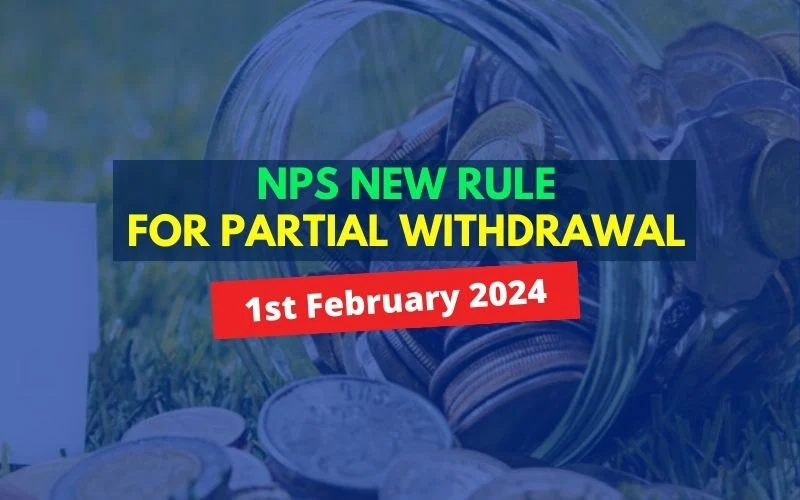Early partial withdrawal is now possible with the NPS new rule effective from 1 February 2024. The NPS (National Pension System) is a voluntary, defined contribution (the contribution rule is already defined) retirement savings scheme launched by the Government of India in 2004. NPS aims to provide retirement benefits to Indian citizens who subscribe to it. The NPS is regulated by Pension Fund Regulatory and Development Authority (PFRDA) and managed by PFRDA-registered Pension Fund Managers. It is open to a subscription to all Indian citizens between the ages of 18 and 65.
The NPS offers its subscribers significant tax benefits, making it an attractive investment option for those looking to save for retirement systematically while reducing their tax liability. You must read my article on NPS Tax Benefit, for netter tax and retirement planning.

NPS New Rule: Which NPS Subscriber Can Opt For Partial Withdrawal?
To initiate a partial withdrawal, you qualify if you have been a subscriber in the NPS for a minimum of 3 years starting from your enrollment date. Here are the specific conditions and guidelines for partial withdrawals:
- You are allowed a maximum of 3 partial withdrawals throughout the duration of your NPS account.
- At any given point, you can withdraw up to 25% of your personal contributions to the NPS, excluding any contributions made by your employer.
- Additionally, you can only withdraw 25% of your contributions between two consecutive partial withdrawals. This ensures a controlled and staggered withdrawal process.
Note: There are no changes on which subscriber can withdraw.
Let’s understand the maximum partial withdrawal allowed with an example
Assume Mr. X deposits Rs. 50,000 per annum (without missing any year), and on the 5th, 11th, and 16th year, he needs to arrange funds for specific conditions where NPS is now the last resort. Here is how he can withdraw.
(Note: In this example, for simplicity’s sake, I’m ignoring the capital gain on the investment.)
➡️Withdrawal-1: 5th year
First, 4 years total Contribution = 50,000 *4 = 2 lakhs
Max, withdrawal allowed 25% of Rs. 2 lakhs = 50,000
➡️Withdrawal-2: 11th year
From 5th – 10th years total 6 Contribution = 50,000 *6 = 3 lakhs
Max, withdrawal allowed 25% of Rs. 3 lakhs = 70,000
➡️Withdrawal-3: 16th year
From 11th – 15th years total 4 Contribution = 50,000 *4 = 2 lakhs
Max, withdrawal allowed 25% of Rs. 2 lakhs = 50,000
New NPS Old Vs. NPS New Rule
Before proceeding with the NPS new rule, let’s understand the partial withdrawal earlier rules and then compare the changes.
Partial withdrawal from NPS is allowed for the following purposes, as mentioned by the PFRDA.
| Sl. No. | Old Rule | Change in Rule |
|---|---|---|
| 1 | For children’s higher education | PFRDA Clarified: including a legally adopted child |
| 2 | For children’s marriage | PFRDA Clarified: including a legally adopted child |
| 3 | Purchase or construction of a residential house or flat in own name or a joint name with spouse | They are now restricted to first-house purchase/construction only. Subscribers with a residential property are restricted from initiating partial withdrawals specifically for this purpose. |
| 4 | Specified illnesses* that involve hospitalization and treatment, either for self or spouse, children, or dependent parents | PFRDA Clarified: including a legally adopted child |
| 5 | – | For meeting medical and incidental expenses arising out of a disability or incapacitation suffered |
| 6 | – | For meeting expenses for skill development or re-skilling, or any other self-development activities, as permitted by PFRDA |
| 7 | – | For the establishment of your venture or start-up, as permitted under PFRDA guidelines |
*Partial withdrawal is permissible for 14 specific diseases, including other life-threatening critical illnesses, as stipulated in circulars, notifications, or guidelines released by PFRDA at various intervals. These include:
- Cancer
- Stroke
- Coma
- Paralysis
- Kidney failure (end-stage renal failure)
- Heart valve surgery
- Major organ transplant
- Total blindness
- Multiple sclerosis
- Primary pulmonary arterial hypertension
- Myocardial infarction
- Coronary artery bypass graft
- Aorta graft surgery
- Accident of a serious or life-threatening nature
NPS New Rule: Withdrawal Process
You can submit a withdrawal request and relevant documents to the POP / Nodal Office / to process your withdrawal claim.
However, if the subscriber is suffering from any illness as specified above, any of the subscriber’s family members can submit the withdrawal request.
NPS Partial Withdrawal – Should You Withdraw?
Although the NPS allows withdrawals for significant life events like education, marriage, medical emergencies, or home purchases, it’s essential to bear in mind that the primary purpose of the New NPS is to ensure financial security in retirement.
Unless you come across an urgent financial need, preserving your NPS corpus will be wise. You can always work with a SEBI Registered Investment Adviser and plan your finances, including emergency funding, building a corpus for house purchase (majority self-funding), and taking care of health needs so that you don’t get into a situation that forces your NPS partial withdrawal.
This strategy ensures that you capitalize on the scheme’s long-term growth potential, leading to a more secure and financially stable retirement.
Frequently Asked Questions
Q-1: How many times is partial withdrawal allowed in the National Pension Scheme (NPS)?
You are allowed a maximum of 3 partial withdrawals throughout the duration of your NPS account.
Q-2: I own a house jointly with my spouse and want to purchase another house. Can I ask for partial withdrawal?
No, as per changes in the NPS rule, withdrawal from NPS is restricted to the first purchase or construction of the house.





